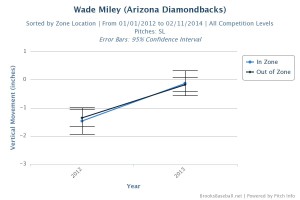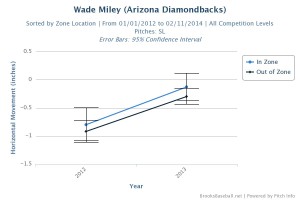What can we expect from Wade Miley in 2014?
In 2012, Wade Miley broke onto the scene with a 3.15 FIP and 4.4 WAR, nearly winning the NL’s Rookie of the Year award. The lefty’s peripherals were good in his first season as well. He walked only 1.71 batters per nine innings and gave up only 0.65 home runs per nine. His BABIP was almost exactly in line with league average, but other statistics indicate he was the beneficiary of luck in 2012. His HR/FB % was 6.9, while the league average was 11.3.
In 2013 Miley had a higher FIP (3.98) and was worth fewer wins above replacement (2.0). Most of the change in performance seems to have come from his propensity to give up home runs. His HR/FB % skyrocketed to 12.5. With a nearly identical xFIP (FIP with a normalized HR/FB rate of 10.5) in 2012 and 2013, it seems as though Miley got lucky and unlucky in subsequent seasons. So we could just call it a wash, and consider his propensity to give up home runs around average across his two seasons.
But something really interesting happened in his second season. The lefty induced almost 10% more groundballs. This means that he gave up less fly balls. So even though his HR/FB rate increased 81.2%, he didn’t give up 81.2% more home runs. His newfound ability to produce groundballs mitigated his bad luck.
So there are a few things that changed for Miley from 2012 to 2013: he walked more batters, gave up more homers, and induced more groundballs.
Let’s address the walks first. Across the board, each one of Miley’s pitches were strikes less often. The main issue seems to be that hitters were more selective against Wade, although lesser command could have played a factor as well. According to Fangraphs, batters swung at 44.1% of pitches in 2013, down 5% from the previous year. This led to more pitches thrown—he threw more than one additional pitch per inning in 2013. This could lead to somewhere between five and ten pitches per game, and considering that pitchers get worse as the game goes on, this could have been a factor in his increase in home runs. More pitches also means that batters are getting deeper into counts, so walks are more likely.
As I was looking at the Pitchf/x data, another thing caught my eye. In 2012, the software said that Miley threw no sliders, but a curveball around 15% of the time. Then in 2013 they said Miley threw the curveball 3.1% of the time and a slider 15.1% of the time. Miley does in fact throw a curveball once in a blue moon, but it’s clear that the software mislabeled some pitches.
This is only interesting because Pitchf/x labeled the pitch correctly in 2013. So what changed? Well, for starters the pitch was thrown at an average speed of 80.9 MPH in 2012, but climbed 83.4 MPH in 2013. This is 2.5 MPH change is strange because the speed of his fastball was consistent, although his changeup was a tick faster as well.
I bring this up because Miley’s slider seemed to lose a bit of its movement in 2013. Luckily, Brooks Baseball manually labels pitches. Let’s look at their data which charts the movement of his slider in both years:
(click to enlarge)

It’s pretty easy to see that the 2012 sliders had not only more downward movement, but some horizontal movement too. Pitchf/x lists Miley’s 2012 “curveball” as 2.3 runs above average, and his slider as -4.4 runs above average in 2013. Or in other words, his slider was about seven runs worse. Maybe it wasn’t the cause of his lesser results, but it certainly contributed.
This change in his slider is particularly interesting because Wade noted that he started throwing his slider harder in 2012. Wade Miley and America’s First Baseman Paul Goldschmidt used to carpool together and Goldy told Miley that he used to throw his slider much harder in college. Miley said of Goldy’s comment: “That got me thinking and so I started to experiment with throwing it as hard as I can. I was able to feel it and throw it for strikes and I’ve just kind of ran with it.” So if he was throwing it as hard as he could in 2012 and 2013, it’s possible that his arm was stronger in 2013, making the slider faster but losing some of its movement in the process.
Hitters were more patient against Wade in 2013—there’s nothing he can do about that. He can do something about the decreased movement in his slider though. Hopefully the kinks are worked out in spring training, and this is his best season yet. In 2014, keep an eye on Wade Miley’s slider.
2 Responses to What can we expect from Wade Miley in 2014?
Leave a Reply Cancel reply
Recent Posts
@ryanpmorrison
 Best part of Peralta’s 108 mph fliner over the fence, IMHO: that he got that much leverage despite scooping it out… https://t.co/ivBrl76adF, Apr 08
Best part of Peralta’s 108 mph fliner over the fence, IMHO: that he got that much leverage despite scooping it out… https://t.co/ivBrl76adF, Apr 08 RT @OutfieldGrass24: If you're bored of watching Patrick Corbin get dudes out, you can check out my latest for @TheAthleticAZ. https://t.co/k1DymgY7zO, Apr 04
RT @OutfieldGrass24: If you're bored of watching Patrick Corbin get dudes out, you can check out my latest for @TheAthleticAZ. https://t.co/k1DymgY7zO, Apr 04 Of course, they may have overtaken the league lead for outs on the bases just now, also...
But in 2017, Arizona ha… https://t.co/38MBrr2D4b, Apr 04
Of course, they may have overtaken the league lead for outs on the bases just now, also...
But in 2017, Arizona ha… https://t.co/38MBrr2D4b, Apr 04 Prior to the games today, there had only been 5 steals of 3rd this season (and no CS) in the National League. The… https://t.co/gVVL84vPQ5, Apr 04
Prior to the games today, there had only been 5 steals of 3rd this season (and no CS) in the National League. The… https://t.co/gVVL84vPQ5, Apr 04 RT @OutfieldGrass24: Patrick Corbin has a WPA of .318 and it's only the fifth inning., Apr 04
RT @OutfieldGrass24: Patrick Corbin has a WPA of .318 and it's only the fifth inning., Apr 04
Powered by: Web Designers@outfieldgrass24
 Old friend alert https://t.co/xwSHU0F8Hn, 1 hour ago
Old friend alert https://t.co/xwSHU0F8Hn, 1 hour ago Every once in a while you get a beer that's just a little off... Usually happens to me at airports., 7 hours ago
Every once in a while you get a beer that's just a little off... Usually happens to me at airports., 7 hours ago If Pollock doesn’t sign with a team that wears red uniforms I’m going to be really disappointed. Working theory: Se… https://t.co/zHn9DqzEiD, 9 hours ago
If Pollock doesn’t sign with a team that wears red uniforms I’m going to be really disappointed. Working theory: Se… https://t.co/zHn9DqzEiD, 9 hours ago The work here by @Britt_Ghiroli is splendid https://t.co/c8tSq0vw3T, 9 hours ago
The work here by @Britt_Ghiroli is splendid https://t.co/c8tSq0vw3T, 9 hours ago RT @TheAthleticAZ: Plenty of #Dbacks fans gave it some time - and they still don't like the idea. The "why" from @ZHBuchanan
https://t.co/9oDlvue3fV, 17 hours ago
RT @TheAthleticAZ: Plenty of #Dbacks fans gave it some time - and they still don't like the idea. The "why" from @ZHBuchanan
https://t.co/9oDlvue3fV, 17 hours ago
Powered by: Web Designers






[…] He does, however, have some trouble finding the zone regularly, triggering the Zone% indicator. As Rod pointed out just last week, Miley had some struggles in 2013 that look fixable. He’s yet to hit the DL and hopefully he’ll […]
There is a mean momma out there looking for stats